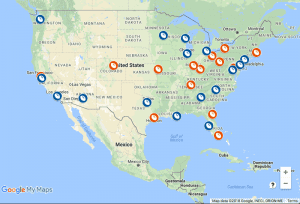Middle school, high school and college students use intermediate or “university” paper with a distance of 9/32 inches between the lines. This is the type of paper that has closer lines to allow more writing on a single page. The term “college” is colloquial language used to indicate that students have completed the use of a general rules document. Older children usually have smaller writing than younger children and don`t need the greater distance. However, teenagers and students would much prefer a wide paper to write essays and book reports. The only requirement for a block of writing paper to qualify as a “legal block” is that the paper must have a vertical line of 1-1/4″ (also known as a “descending line”) placed from the left edge of the page. The original and traditional appearance of the legal stamp had yellow paper, blue horizontal lines, a red vertical line that formed a left edge and a rubberized red top. Today, this is no longer the case. Note: A “legal stamp” does not mean that the paper size on the stamp itself is in legal size (8-1/2 “L x 14″ L), although it can be ordered this way. A legal stamp simply means that the paper on the stamp has a vertical line that is pulled down, creating a 1-1/4” edge from the left side. No.
The original Legal Pad was made by dying the yellow paper. Apart from speculation, no one really knows why. In fact, it is more expensive to buy a yellow legal tampon than a white tampon. Today, there are legal stamps (with the 1-1/4″ border on the left) in a variety of colors: initially, the paper was set by hand, sometimes with templates. [1] Editors could govern their paper with a “hard tip,” a sharp device that left raised lines on the paper without ink or paint,[2] or they could use a “metal tip,” a tool that left colored marks on the paper, similar to a graphite pen, although various other metals were used. [3] Overall, widely used paper is the preferred choice of primary school teachers. This is a particularly common sight in kindergarten, in the classrooms of the first, second and third grades. The reason for this is quite simple: young children who just learn to spell their names usually scribble them in very large letters, so they need paper that has a lot of space between the lines. You need to scrape loose sheets of paper from the list. On the shelves you will see Wide Rule and College Ruled notebook paper.
Luckily for you, your son or daughter`s teacher specifically wrote down the type of paper needed for their year. But what if you hadn`t looked at the list and picked up a packet of notebook paper you found? Is there a big difference? Are not all the paperwork to be completed the same? No matter what brand of loose-leaf paper you buy, wide paper and college rule paper all have the same type of spacing. There is virtually no difference in the quality of regulated paper from one brand to another. However, this is not the same when it comes to computer printer paper, as it has different types of printing applications and is often classified by weight, type, and color. Finally, there are the aptly named narrow rule sheets. If you have trouble reading tiny letters, this type of stationery is not for you. Nearly 8/32 inches (0.25 inches or 6.35 millimeters) or less separate the lines on tightly regulated paper. Then we have a moderately regulated document – or “governed by a college”.
Leaves of this type have slightly smaller line spacing spaces of only 9/32 inches (7.1 millimeters). The New Zealand Standard for School Paper, 1984, sets standards for regulated and unregulated paper. To promote the discipline of handwriting, a type of rule known as the Seyès judgment[8] is used in schools. Heavy vertical lines are spaced 8 mm (about 5/16 in.) apart and start 16 mm (about 5/8 in.) from the left edge of the side. Three lighter lines have a distance of 2 mm (about 5/64 in.) between each pair of heavy lines. [9] These sheets are commonly referred to as large tiles, unlike small tiles that measure 5×5 mm. Seyès rule paper is available in single sheets (single copies) or double joined sheets (double sheet copies), which are sometimes preferred for testing because they are easier to handle. There are many types of doubled notebook paper, and each has a different name – college ruled among them. To distinguish them from each other, you may need to break a rule. DIN 16552:1977-04 (“Lines for Handwriting”) specifies the types of rule documents to be used by students. [10] Elementary school students use (田字格) Tianzige rule paper with boxes for individual characters.
Sometimes each box is divided into references (vertical, horizontal, diagonal) to help the author with the relative proportion and placement of character components. For elementary school-age children, widely used paper is the preferred choice for K-4 students. The ruler lines are spaced 11/37 inches apart and are intended for children who are still learning to write letters and numbers, as well as people who have above-average handwriting. “Statué” or “Statuant” simply refers to the horizontal lines on the paper. But! Ruler lines occur in different widths and therefore create more or fewer lines on the sheet of paper. The first of these is called a broad rules document, which has large differences between individual lines. Typically, these empty divisions have a width of 11/32 inches (about 8.7 millimeters) or a width. Before proceeding, a certain historical context is required.
Paper printed with horizontal lines evenly distributed over its surface is called “regulated” paper. For centuries, these lines had to be drawn by hand. But in 1770, the situation changed. In June of the same year, inventor John Tetlow patented a device that the British government described as a “machine for regulating paper for music and other purposes.” By the way, Tetlow named the device after himself. Since then, the rules document has evolved considerably. Here in North America, manufacturers recognize three main varieties: “College ruled” paper is so called because it is what older students usually use. As children get older, they are able to write smaller letters, numbers, and symbols. Therefore, most of them will have graduated from Wide Ruled to Medium Ruled Sheets by the time they enter high school. And in most colleges, middle paper notebooks are ubiquitous – although many students are still widespread fans. To each his own. Legal notebooks may or may not be ordered with a court decision and in paper format.
In fact, neither the width of the rules (or lines) on the paper nor the size of the paper on the block classify a block of paper as a “legal block”. If you`re still not sure, here are some helpful tips for understanding which legal stamp you need to order. There does not seem to be a British standard, but the line spacing for adult ruler paper is most often 8 mm and square mathematical paper is 5 mm². For primary schools, there is a special writing paper (“Education standard Learn to Write Exercise books”) and a British standard BS4448 (“Specification for workbooks and school papers”). You will find ruler paper at a distance of 15 mm and square mathematical paper at a distance of 10 mm². Anything above primary school tends to use adult regulation. In North America, control paper is available in a variety of semi-standardized formats. Keep in mind that all legal notebooks have a vertical line drawn 1-1/4″ from top to bottom on the left side of the paper to create a border: rule paper (or lined paper) is printed writing paper with lines as a guide for handwriting. The lines are often printed with a thin width and light color and this paper is sometimes called Feint control paper. Additional vertical lines can provide margins or serve as tab stops, or create a grid to plot the data. For example, graphic paper (square paper or lattice paper) is divided into squares by horizontal and vertical lines. The lines in the rules document provide guidance that allows users to keep their font or drawing consistent with a given set of rules.
The authoritative layout is not determined by the size of the paper, but by the purpose, style of handwriting, or language used. Many different line layouts support handwriting, calligraphy, plotting data in diagrams, music notation, or helping students write in a specific language or script. Here are some common examples: The next time someone says; “Order me legal stamps, right?” You`ll know you have to follow: “Of course, I`d love to do it. First of all, tell me… At first glance, it`s easy to tell the difference. The “regulated” lines are further apart on the broad rules document than on the college`s rules paper, hence the name. There are six other types of paper that have specific uses but are not often seen. Other types of paper include: This form is protected by reCAPTCHA and Google`s privacy policy and terms of service apply. In North America, we are generally used to reading width, length and height in fractions as opposed to decimals or millimeters. Therefore, legal stamps are usually available in four different sizes: among other things, Genkō Yōshi (原稿用紙, “handwritten paper”) is a type of paper primarily used to write kanji fonts, formed vertically with individual boxes for each Chinese character….


